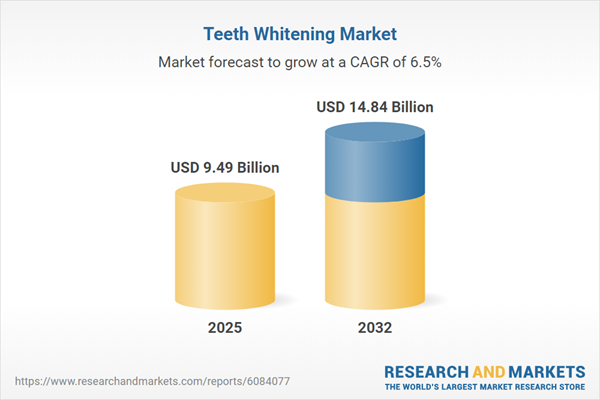Speak directly to the analyst to clarify any post sales queries you may have.
The teeth whitening market is evolving rapidly, driven by technological advancements, changing consumer expectations, and increased professional and at-home adoption. Stakeholders face a shifting landscape where innovation, compliance, and customer engagement determine competitive edge.
Market Snapshot: Teeth Whitening Market Size and Growth
The global teeth whitening market grew from USD 8.93 billion in 2024 to USD 9.49 billion in 2025 and is expected to expand at a CAGR of 6.54%, reaching USD 14.84 billion by 2032. Consistent growth is fueled by rising consumer interest in cosmetic oral care, as well as increased focus on personal appearance and wellness. Demand spans both professional and at-home solutions, with robust adoption by dental practices and individuals seeking effective, reliable results.
Scope & Segmentation: Teeth Whitening Market Overview
This report delivers a comprehensive analysis of the teeth whitening industry, highlighting essential segments and strategic priorities for decision-makers seeking actionable intelligence.
- Product Types: The landscape includes charcoal powders, advanced lamp-based solutions (LED and UV), professional whitening systems, foams, gels, pens, mouthwashes, strips, and toothpastes—each addressing unique user preferences and application requirements.
- Ingredient Types: Sector analysis covers carbamide peroxide, hydrogen peroxide, and a variety of natural agents such as botanicals, appealing to both conventional and wellness-oriented consumers.
- Distribution Channels: Multi-channel distribution involves offline points of sale including pharmacies, drugstores, supermarkets, and hypermarkets, as well as online direct-to-consumer pathways through brand-managed websites and eCommerce platforms.
- Applications: Solutions cater to extrinsic stains (diet and lifestyle-related) and intrinsic discoloration (aging or health conditions), ensuring broad relevance across demographic segments.
- End Users: Dental clinics, aesthetic-focused dental professionals, and the growing segment of individual consumers all play pivotal roles in market expansion.
- Regions: Coverage encompasses the Americas (North America and Latin America), Europe, the Middle East, Africa, and Asia-Pacific, supported by granular country-level intelligence in key geographic hotspots.
- Companies Covered: The competitive landscape features leading multinationals such as Colgate-Palmolive, Procter & Gamble, Johnson & Johnson, Unilever, GSK, Henkel, Philips, alongside a suite of innovative organizations driving continual progress within the sector.
Key Takeaways: Strategic Insights Shaping the Teeth Whitening Market
- Growing consumer emphasis on convenience and proven outcomes is accelerating product innovation and widening delivery options in both clinical and at-home segments.
- LED and UV-enabled technologies now empower at-home users to access advanced solutions, closely mirroring those traditionally offered in professional settings while emphasizing safety and personalization.
- Ingredient demand is diversifying, with hydrogen peroxide remaining dominant for clinical use, and botanically based alternatives appealing to consumers seeking gentle, nature-derived products.
- Brands increasingly leverage direct-to-consumer and subscription-driven engagement to enhance customer loyalty, utilize data-driven personalization, and unlock new growth opportunities.
- Ongoing regulatory developments impact safety and labeling practices; alliances with dental associations are vital for product validation and sustained access to evolving markets.
- Changes in supply chains, especially trends towards local production and efficient packaging, are reshaping brand competitiveness by managing costs and improving responsiveness to regional needs.
Tariff Impact: Navigating Trade Changes in the Teeth Whitening Industry
Pending import duties in the United States are prompting manufacturers to reexamine their supply strategies. Many are developing domestic supplier partnerships, optimizing procurement networks, and introducing value engineering to navigate the increased costs of importing ingredients and equipment. In response to higher raw material and packaging expenses, premium brands are redefining product tiers and pricing strategies to balance margins, while smaller firms are capitalizing on regional distribution efficiencies to maintain market presence.
Teeth Whitening Market Research Methodology & Data Sources
This analysis integrates primary research, including structured interviews with dental professionals and cosmetic specialists, as well as direct field observations in clinical and retail contexts. Findings are corroborated through secondary reviews of peer-reviewed studies, regulatory documents, and industry white papers, with expert panels ensuring result reliability.
Why This Report Matters: Actionable Insights for B2B Leaders
- Pinpoint high-potential market entry strategies and commercialization routes across multiple segments and critical geographic regions.
- Strengthen supply chain agility and minimize risk by anticipating regulatory, trade, and technological shifts relevant to the sector.
- Utilize research-driven insights into consumer, technological, and compliance trends to inform investment, development, and partnership decisions with confidence.
Conclusion
Rapid innovation, tightening regulation, and changing consumer priorities define the trajectory of the teeth whitening market. Success hinges on anticipating shifts and fostering value chain collaboration to sustain competitive positioning.
Table of Contents
3. Executive Summary
4. Market Overview
7. Cumulative Impact of Artificial Intelligence 2025
Companies Mentioned
The companies profiled in this Teeth Whitening market report include:- AuraGlow
- Beaming White LLC
- BMS DENTAL SRL
- Brodie & Stone International PLC.
- CCA Industries, Inc.
- Church & Dwight Co. Inc.
- Colgate-Palmolive Company
- Creightons PLC
- GlaxoSmithKline PLC
- GoSmile, LLC
- Henkel AG & Co. KGaA
- Himalaya Wellness Company
- Johnson & Johnson Services, Inc.
- Koninklijke Philips N.V.
- NuYu Teeth Whitening LLC
- Oh! White
- ORALGEN Nupearl
- Pearly Whites
- Procter & Gamble Company
- Supersmile
- Ultradent Products Inc.
- Unilever PLC
- WHITEsmile GmbH
- WSD Labs USA Inc.
- Zhengzhou Huaer Electro Optics Technology Co. Ltd.
Table Information
| Report Attribute | Details |
|---|---|
| No. of Pages | 185 |
| Published | November 2025 |
| Forecast Period | 2025 - 2032 |
| Estimated Market Value ( USD | $ 9.49 Billion |
| Forecasted Market Value ( USD | $ 14.84 Billion |
| Compound Annual Growth Rate | 6.5% |
| Regions Covered | Global |
| No. of Companies Mentioned | 26 |









